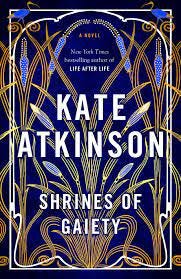Novel Justice
It’s fun to watch a veteran storyteller complete a jigsaw puzzle of her own making
I wasn’t sure I wanted to read Kate Atkinson’s Shrines of Gaiety. I consider myself a fan of the Scottish novelist; she’s one of those rare people—Ian McEwan is another—who can write page-turning postmodern fiction. She’s also someone, like fellow Brit Islanders J.K. Rowling and John Banville, who include suspenseful detective novels as part of their literary repertoire. (The first book I read of Atkinson’s was the 2004 novel Case Histories, featuring her character Jackson Brodie, which became the basis of a BBC series.) Her 2013 novel Life After Life was a tour de force of narrative manipulation, repeatedly killing off her protagonist (beginning with a failed assassination attempt of Adolf Hitler) and restarting the story over and over again while simultaneously building on its layers. The 2015 sequel to that book, A God in Ruins, takes a character from Life After Life who died in combat during World War II and narrates the life he would have had if he lived. It’s wonderful.
Still, Shrines of Gaiety, which was published last fall, somehow seemed forbidding, and sat on my living-room pile of reading for a while. For one thing, it’s a big book. For another, its setting—London in the 1920s—did not strike me as immediately gripping. (Paris in the twenties? Sure. New York? Absolutely. But were the twenties really a London decade, like, say, the sixties? Not really.) Once I started, though, it didn’t take long to get hooked. Atkinson is so deft, so totally in control of her material, that you just sit back and enjoy the ride.
She renders this one in the key of Dickens. We meet any number of characters who might have wandered in from David Copperfield or Bleak House: the gruff detective with a soft heart (and sharp mind); the quick-witted ingenue who can think on her feet (and off them); the dim (but kind) companion whose life is a bit more mysterious than one might have thought; and so on. At the center of the story is Nellie Coker, the ruthless owner of a series of nightclubs who, as we encounter her in the opening chapter, is just being released from prison. (The character is based on a real-life figure, Kate Meyrick; her obituary, included at the back of the book, includes the phrase “shrines of gaiety” in reference to the clubs she operated, one that carries with it more than a few traces of irony.) Nellie has five children she has raised with varying degrees of attention and affection, most of whom now work for her in one capacity or another. She remains besieged by the law on one hand and rivals in crime on the other.
Against this backdrop there are a few other narrative strands. They include the aforementioned detective, John Frobisher, unhappily married and doggedly investigating the mysterious murders of young women dumped in the Thames; Gwendolyn Kelling, a former librarian from York who comes to London to help find a pair of girls who have fled their hometown—her story intertwines with that of the Crokers as well as Frobisher—and one of those girls, fourteen-year-old Freda Murgatroyd, who has come to the Big City to make it in show business.
Atkinson weaves her tale in short chapters that alternate between such protagonists, maintaining a kind of Victorian pitch in her storytelling even as she showcases her penchant for fractured chronology (which she uses to build suspense). There are lots of metatextual Easter Eggs for those attuned to catch them, like the mediocre novelist who mentions that he had “a very interesting conversation about bullfighting with an American chap called Hemingway, a journalist who writes stories.”
The setting for the story, London in 1926, is ably evoked. The long shadow of the First World War lingers, in a city and people who have been hollowed out and craving a good time. Unlike the United States, liquor is legal, but there’s still plenty of organized crime in managing it.
The real suspense in Shrines of Gaiety is less about whether Nellie Croker will survive, or what will become of Freda, than how Atkinson will complete the puzzle she created for herself: the way the moral scales of all of this will be sorted out and resolved. Gwendolyn becomes involved in a love triangle between Frobisher and Nellie’s son Niven—you end up liking them both and wonder how she’s going to choose between them. The Crokers are criminals who probably deserve to be brought down, except that their enemies, which include corrupt lawmen, seem even worse. In any event, it seems hard to believe, in art or life, that conventional standards of justice can satisfy our curiosity.
What’s needed, then, is poetic justice (or, more accurately, novel justice). In the last fifty pages of the novel, Atkinson doles it out at a steady pace, stitching the thread of the plot in a series of directions, including distinctly postmodern ones. “He stood up abruptly and held out his hand to her. And there they must remain, suspended between coming and going forever,” she says of one “ending” that calls attention to the artifice of fiction. Some of these resolutions are surprising and satisfying; some are unsettling, as Atkinson surely intends. Like so much of her work, Shrines of Gaiety is a story—and a story about storytelling.
What makes her so impressive is that she manages to keep both in equipoise. “I’m writing a novel,” Nellie’s son Ramsay tells Freda at one point in the story. “As if that was something to crow about,” she thinks, “as if there weren’t enough novels in the world already.” But there will always be room for those happy few whose dazzling grace make it a joy to witness their craft. Kate Atkinson is gifted, and her work is a gift.




